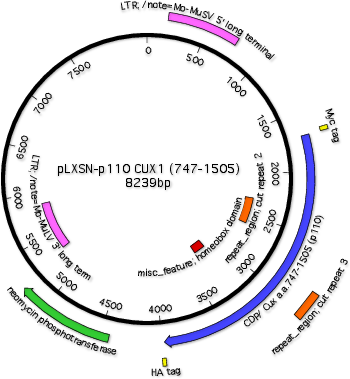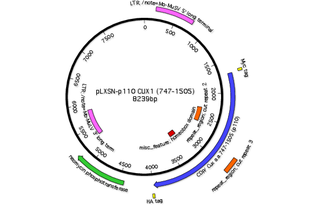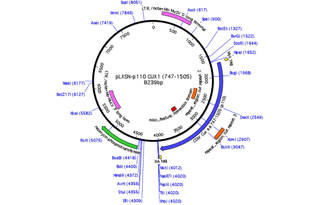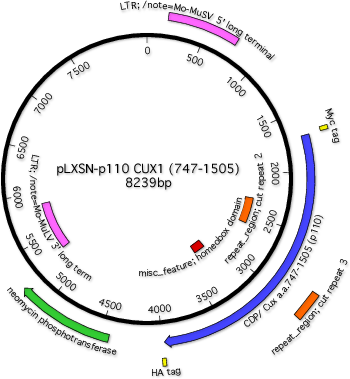pLXSN p110 CUX1
(Plasmid
#90471)
-
PurposeRetroviral vector expressing human p110 CUX1 (amino acids 747-1505) with a Myc and HA tag at the N- and C-terminue, respectively
-
Depositing Lab
-
Sequence Information
Ordering
| Item | Catalog # | Description | Quantity | Price (USD) | |
|---|---|---|---|---|---|
| Plasmid | 90471 | Standard format: Plasmid sent in bacteria as agar stab | 1 | $89 | |
Backbone
-
Vector backbonepLXSN
-
Backbone manufacturerMiller, A.D.
- Backbone size w/o insert (bp) 5875
- Total vector size (bp) 8240
-
Vector typeMammalian Expression, Retroviral
-
Selectable markersNeomycin (select with G418)
Growth in Bacteria
-
Bacterial Resistance(s)Ampicillin, 100 μg/mL
-
Growth Temperature37°C
-
Growth Strain(s)NEB Stable
-
Copy numberHigh Copy
Gene/Insert
-
Gene/Insert nameCUX1 (amino acids 747-1505)
-
Alt nameCCAAT-displacement protein
-
Alt nameCut-like 1
-
SpeciesH. sapiens (human)
-
Insert Size (bp)2368
-
GenBank IDM74099
-
Entrez GeneCUX1 (a.k.a. CASP, CDP, CDP/Cut, CDP1, COY1, CUTL1, CUX, Clox, Cux/CDP, GDDI, GOLIM6, Nbla10317, p100, p110, p200, p75)
- Promoter Moloney murine leukemia virus long terminal repeat
-
Tags
/ Fusion Proteins
- Myc (N terminal on insert)
- HA (C terminal on insert)
Cloning Information
- Cloning method Restriction Enzyme
- 5′ cloning site HpaI (not destroyed)
- 3′ cloning site HpaI (not destroyed)
- 5′ sequencing primer GTCTCTCCCCCTTGAACC
- 3′ sequencing primer CCACACCCTAACTGACACAC (Common Sequencing Primers)
Terms and Licenses
-
Academic/Nonprofit Terms
-
Industry Terms
- Not Available to Industry
Trademarks:
- Zeocin® is an InvivoGen trademark.
These plasmids were created by your colleagues. Please acknowledge the Principal Investigator, cite the article in which the plasmids were described, and include Addgene in the Materials and Methods of your future publications.
-
For your Materials & Methods section:
pLXSN p110 CUX1 was a gift from Alain Nepveu (Addgene plasmid # 90471 ; http://n2t.net/addgene:90471 ; RRID:Addgene_90471) -
For your References section:
p110 CUX1 homeodomain protein stimulates cell migration and invasion in part through a regulatory cascade culminating in the repression of E-cadherin and occludin. Kedinger V, Sansregret L, Harada R, Vadnais C, Cadieux C, Fathers K, Park M, Nepveu A. J Biol Chem. 2009 Oct 2;284(40):27701-11. doi: 10.1074/jbc.M109.031849. Epub 2009 Jul 27. 10.1074/jbc.M109.031849 PubMed 19635798












